
Patellofemoral Pain Syndrome
This article is also available in Spanish: El síndrome de dolor patelofemoral (Patellofemoral Pain Syndrome).
Patellofemoral pain syndrome is a broad term used to describe pain in the front of the knee and around the patella, or kneecap. It is sometimes called "runner's knee" or "jumper's knee" because it is common in people who participate in sports—particularly females and young adults—but patellofemoral pain syndrome can occur in nonathletes, as well. The pain and stiffness it causes can make it difficult to climb stairs, kneel down, and perform other everyday activities.
Many things may contribute to the development of patellofemoral pain syndrome. Problems with the alignment of the kneecap and overuse from vigorous athletics or training are often significant factors.
Symptoms are often relieved with conservative treatment, such as changes in activity levels or a therapeutic exercise program.
Anatomy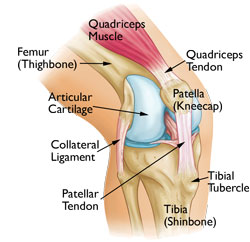 Normal knee anatomy
Normal knee anatomy
Your knee is the largest joint in your body and one of the most complex. It is made up of the lower end of the femur (thighbone), the upper end of the tibia (shinbone), and the patella (kneecap).
Ligaments and tendons connect the femur to the bones of the lower leg. The four main ligaments in the knee attach to the bones and act like strong ropes to hold the bones together.
Muscles are connected to bones by tendons. The quadriceps tendon connects the muscles in the front of the thigh to the patella. Segments of the quadriceps tendon—called the patellar retinacula—attach to the tibia and help to stabilize the patella. Stretching from your patella to your tibia is the patellar tendon.
Several structures in the knee joint make movement easier. For example, the patella rests in a groove on the top of the femur called the trochlea. When you bend or straighten your knee, the patella moves back and forth inside this trochlear groove.
A slippery substance called articular cartilage covers the ends of the femur, trochlear groove, and the underside of the patella. Articular cartilage helps your bones glide smoothly against each other as you move your leg.
Also aiding in movement is the synovium—a thin lining of tissue that covers the surface of the joint. The synovium produces a small amount of fluid that lubricates the cartilage. In addition, just below the kneecap is a small pad of fat that cushions the kneecap and acts as a shock absorber.
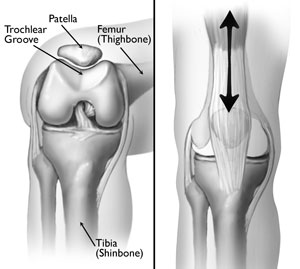 (Left) The patella normally rests in a small groove at the end of the femur called the trochlear groove. (Right) As you bend and straighten your knee, the patella slides up and down within the groove.
Description
(Left) The patella normally rests in a small groove at the end of the femur called the trochlear groove. (Right) As you bend and straighten your knee, the patella slides up and down within the groove.
Description
Patellofemoral pain syndrome occurs when nerves sense pain in the soft tissues and bone around the kneecap. These soft tissues include the tendons, the fat pad beneath the patella, and the synovial tissue that lines the knee joint.
In some cases of patellofemoral pain, a condition called chondromalacia patella is present. Chondromalacia patella is the softening and breakdown of the articular cartilage on the underside of the kneecap. There are no nerves in articular cartilage—so damage to the cartilage itself cannot directly cause pain. It can, however, lead to inflammation of the synovium and pain in the underlying bone.
CauseOveruse
In many cases, patellofemoral pain syndrome is caused by vigorous physical activities that put repeated stress on the knee —such as jogging, squatting, and climbing stairs. It can also be caused by a sudden change in physical activity. This change can be in the frequency of activity—such as increasing the number of days you exercise each week. It can also be in the duration or intensity of activity—such as running longer distances.
Other factors that may contribute to patellofemoral pain include:
- Use of improper sports training techniques or equipment
- Changes in footwear or playing surface
Patellar Malalignment
Patellofemoral pain syndrome can also be caused by abnormal tracking of the kneecap in the trochlear groove. In this condition, the patella is pushed out to one side of the groove when the knee is bent. This abnormality may cause increased pressure between the back of the patella and the trochlea, irritating soft tissues.
Factors that contribute to poor tracking of the kneecap include:
- Problems with the alignment of the legs between the hips and the ankles. Problems in alignment may result in a kneecap that shifts too far toward the outside or inside of the leg, or one that rides too high in the trochlear groove—a condition called patella alta.
- Muscular imbalances or weaknesses, especially in the quadriceps muscles at the front of the thigh. When the knee bends and straightens, the quadriceps muscles and quadriceps tendon help to keep the kneecap within the trochlear groove. Weak or imbalanced quadriceps can cause poor tracking of the kneecap within the groove.
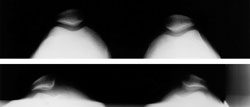 (Top) In these x-rays taken from above, both kneecaps are normally aligned within the trochlear groove. (Bottom) Here, both kneecaps have shifted out of the trochlear groove and are pulled toward the outside of the knee.
Reproduced with permission from JF Sarwark, ed: Essentials of Musculoskeletal Care, ed 4. Rosemont, IL, American Academy of Orthopaedic Surgeons, 2010
Symptoms
(Top) In these x-rays taken from above, both kneecaps are normally aligned within the trochlear groove. (Bottom) Here, both kneecaps have shifted out of the trochlear groove and are pulled toward the outside of the knee.
Reproduced with permission from JF Sarwark, ed: Essentials of Musculoskeletal Care, ed 4. Rosemont, IL, American Academy of Orthopaedic Surgeons, 2010
Symptoms
The most common symptom of patellofemoral pain syndrome is a dull, aching pain in the front of the knee. This pain—which usually begins gradually and is frequently activity-related—may be present in one or both knees. Other common symptoms include:
- Pain during exercise and activities that repeatedly bend the knee, such as climbing stairs, running, jumping, or squatting.
- Pain after sitting for a long period of time with your knees bent, such as one does in a movie theater or when riding on an airplane.
- Pain related to a change in activity level or intensity, playing surface, or equipment.
- Popping or crackling sounds in your knee when climbing stairs or when standing up after prolonged sitting.
In many cases, patellofemoral pain will improve with simple home treatment.
Activity Changes
Stop doing the activities that make your knee hurt until your pain is resolved. This may mean changing your training routine or switching to low-impact activities that will place less stress on your knee joint. Biking and swimming are good low-impact options. If you are overweight, losing weight will also help to reduce pressure on your knee.
The RICE Method
RICE stands for rest, ice, compression, and elevation.
- Rest. Avoid putting weight on the painful knee.
- Ice. Use cold packs for 20 minutes at a time, several times a day. Do not apply ice directly on skin.
- Compression. To prevent additional swelling, lightly wrap the knee in an elastic bandage, leaving a hole in the area of the kneecap. Make sure that the bandage fits snugly and does not cause additional pain.
- Elevation. As often as possible, rest with your knee raised up higher than your heart.
Medication
Non-steroidal anti-inflammatory drugs (NSAIDs) such as ibuprofen and naproxen can help reduce swelling and relieve pain.
If you pain persists or it becomes more difficult to move your knee, contact your doctor for a thorough evaluation.
Doctor ExaminationPhysical Examination
During the physical examination, your doctor will discuss your general health and the symptoms you are experiencing. He or she will ask when your knee pain started and about the severity and nature of the pain (dull vs. sharp). Your doctor will also ask you what activities cause the pain to worsen.
To determine the exact location of the pain, your doctor may gently press and pull on the front of your knees and kneecaps. He or she may also ask you to squat, jump, or lunge during the exam in order to test your knee and core body strength.
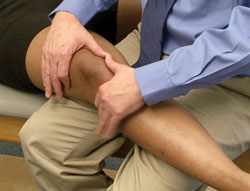 During the examination, your doctor will check your knee for problems in patellar tracking.
Reproduced with permission from JF Sarwark, ed: Essentials of Musculoskeletal Care, ed 4. Rosemont, IL, American Academy of Orthopaedic Surgeons, 2010
During the examination, your doctor will check your knee for problems in patellar tracking.
Reproduced with permission from JF Sarwark, ed: Essentials of Musculoskeletal Care, ed 4. Rosemont, IL, American Academy of Orthopaedic Surgeons, 2010
To help diagnose the cause of your pain and to rule out any other physical problems, your doctor may also check:
- Alignment of the lower leg and the position of the kneecap
- Knee stability, hip rotation, and range of motion of knees and hips
- The kneecap for signs of tenderness
- The attachment of thigh muscles to the kneecap
- Strength, flexibility, firmness, and tone of the hips, front thigh muscles (quadriceps), and back thigh muscles (hamstrings)
- Tightness of the heel cord and flexibility of the feet
Finally, your doctor may ask you to walk back and forth in order to examine your gait (the way you walk). He or she will look for problems with your gait that may be contributing to your knee pain.
X-Rays
Usually, your doctor will be able to diagnose patellofemoral pain syndrome with just a physical examination. In most cases, however, he or she also will order an x-ray to rule out damage to the structure of the knee and to the tissues that connect to it.
TreatmentMedical treatment for patellofemoral pain syndrome is designed to relieve pain and restore range of motion and strength. In most cases, patellofemoral pain can be treated nonsurgically.
Nonsurgical Treatment
In addition to activity changes, the RICE method, and anti-inflammatory medication, your doctor may recommend the following:
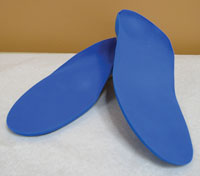 Shoe inserts take stress off your lower leg by aligning your foot and ankle.
Reproduced with permission from JF Sarwark, ed: Essentials of Musculoskeletal Care, ed 4. Rosemont, IL, American Academy of Orthopaedic Surgeons, 2010
Shoe inserts take stress off your lower leg by aligning your foot and ankle.
Reproduced with permission from JF Sarwark, ed: Essentials of Musculoskeletal Care, ed 4. Rosemont, IL, American Academy of Orthopaedic Surgeons, 2010
Physical therapy exercises. Specific exercises will help you improve range of motion, strength, and endurance. It is especially important to focus on strengthening and stretching your quadriceps since these muscles are the main stabilizers of your kneecap. Core exercises may also be recommended to strengthen the muscles in your abdomen and lower back.
Orthotics. Shoe inserts can help align and stabilize your foot and ankle, taking stress off of your lower leg. Orthotics can either be custom-made for your foot or purchased "off the shelf."
Surgical Treatment
Surgical treatment for patellofemoral pain is very rarely needed and is done only for severe cases that do not respond to nonsurgical treatment. Surgical treatments may include:
Arthroscopy. During arthroscopy, your surgeon inserts a small camera, called an arthroscope, into your knee joint. The camera displays pictures on a television screen, and your surgeon uses these images to guide miniature surgical instruments.
- Debridement. In some cases, removing damaged articular cartilage from the surface of the patella can provide pain relief.
- Lateral release. If the lateral retinaculum tendon is tight enough to pull the patella out of the trochlear groove, a lateral release procedure can loosen the tissue and correct the patellar malalignment.
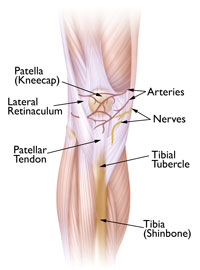 If tightness in the lateral retinaculum is pulling your kneecap to the side, your doctor may recommend lateral release surgery to cut the ligament.
Reproduced with permission from JF Sarwark, ed: Essentials of Musculoskeletal Care, ed 4. Rosemont, IL, American Academy of Orthopaedic Surgeons, 2010
If tightness in the lateral retinaculum is pulling your kneecap to the side, your doctor may recommend lateral release surgery to cut the ligament.
Reproduced with permission from JF Sarwark, ed: Essentials of Musculoskeletal Care, ed 4. Rosemont, IL, American Academy of Orthopaedic Surgeons, 2010
Tibial Tubercle Transfer. In some cases, it may be necessary to realign the kneecap by moving the patellar tendon along with a portion of the tibial tubercle—the bony prominence on the tibia (shinbone).
A traditional open surgical incision is required for this procedure. The doctor partially or totally detaches the tibial tubercle so that the bone and the tendon can be moved toward the inner side of the knee. The piece of bone is then reattached to the tibia using screws. In most cases, this transfer allows for better tracking of the kneecap in the trochlear groove.
PreventionPatellofemoral pain syndrome is usually fully relieved with simple measures or physical therapy. It may recur, however, if you do not make adjustments to your training routine or activity level. It is essential to maintain appropriate conditioning of the muscles around the knee, particularly the quadriceps and the hamstrings.
 Leg extension exercises help to strengthen and stretch the quadriceps, the muscles in the front of the thigh.
Leg extension exercises help to strengthen and stretch the quadriceps, the muscles in the front of the thigh.
There are additional steps that you can take to prevent recurrence of patellofemoral knee pain. They include:
- Wearing shoes appropriate to your activities
- Warming up thoroughly before physical activity
- Incorporating stretching and flexibility exercises for the quadriceps and hamstrings into your warm-up routine, and stretching after physical activity
- Increasing training gradually
- Reducing any activity that has hurt your knees in the past
- Maintaining a healthy body weight to avoid overstressing your knees
If you found this article helpful, you may also be interested in Knee Arthroscopy.
Source: http://orthoinfo.aaos.org/topic.cfm?topic=A00680
